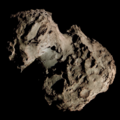99P/Kowal
| Discovery[1] | |
|---|---|
| Discovered by | Charles T. Kowal |
| Discovery site | Palomar Observatory |
| Discovery date | 24 April 1977 |
| Designations | |
| P/1977 H2 P/1991 D2 | |
| |
| Orbital characteristics[3][4] | |
| Epoch | 17 October 2024 (JD 2460600.5) |
| Observation arc | 47.25 years |
| Number of observations | 1,740 |
| Aphelion | 7.489 AU |
| Perihelion | 4.702 AU |
| Semi-major axis | 6.095 AU |
| Eccentricity | 0.22857 |
| Orbital period | 15.049 years |
| Inclination | 4.339° |
| 28.083° | |
| Argument of periapsis | 174.59° |
| Mean anomaly | 60.356° |
| Last perihelion | 12 April 2022 |
| Next perihelion | 6 May 2037[2] |
| TJupiter | 2.956 |
| Earth MOID | 3.724 AU |
| Jupiter MOID | 0.307 AU |
| Physical characteristics[3] | |
Mean diameter | 10.2 km (6.3 mi) |
| Comet total magnitude (M1) | 6.7 |
| Comet nuclear magnitude (M2) | 11.5 |
99P/Kowal, also known as Kowal 1, is a periodic comet in the Solar System that orbits out by Jupiter and has a 15 year orbital period. It has been observed regularly since 2019. Its most recent perihelion occurred in April 2022, and is expected to return by May 2037.[4]
Observational history
[edit]Charles T. Kowal discovered this comet shortly after reporting the discovery of asteroid 2063 Bacchus (then known as 1977 HB) on the night of 24 April 1977.[1] It already passed perihelion when it was first spotted as a 16th-magnitude object within the constellation Virgo.[5] Orbital calculations by Shuichi Nakano and Brian G. Marsden predicted that the comet has a 15-year orbit around the Sun, and was expected to return by 1992.[5] It was successfully recovered by James V. Scotti from the Kitt Peak Observatory's Spacewatch program on 21 February 1991.[6]
Between 12 and 14 May 2021, a small outburst temporarily brightened Comet Kowal 1, which raised its apparent magnitude from 18.32 to 17.6.[7]
References
[edit]- ^ a b C. T. Kowal (26 April 1991). B. G. Marsden (ed.). "Comet Kowal (1977f)". IAU Circular. 3066 (2). Bibcode:1977IAUC.3066....2K.
- ^ "Horizons Batch for 99P/Kowal 1 (90000934) on 2037-May-06" (Perihelion occurs when rdot flips from negative to positive). JPL Horizons. Retrieved 6 July 2023. (JPL#65 Soln.date: 2023-Jul-05)
- ^ a b "99P/Kowal 1 – JPL Small-Body Database Lookup". ssd.jpl.nasa.gov. Jet Propulsion Laboratory. Retrieved 25 May 2025.
- ^ a b "99P/Kowal Orbit". Minor Planet Center. Retrieved 24 February 2019.
- ^ a b G. W. Kronk. "99P/Kowal 1". Cometography.com. Retrieved 26 May 2025.
- ^ J. V. Scotti; B. G. Marsden (23 February 1991). D. W. Green (ed.). "Periodic Comet Kowal 1 (1991i)". IAU Circular. 5195 (1). Bibcode:1991IAUC.5195....1S.
- ^ M. S. P. Kelley (14 May 2021). "Small Apparent Outburst of Comet 99P/Kowal 1". The Astronomer's Telegram. 14628. Bibcode:2021ATel14628....1K.
External links
[edit]- 99P/Kowal at the JPL Small-Body Database
- 99P/Kowal 1 at Seiichi Yoshida's website
- 99P/Kowal 1 at Gary W. Kronk's Cometography


